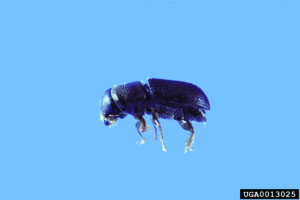Georgia is known for its rich pine tree forests. Unfortunately, southern pine beetles (SPB) are a constant in the Georgia environment, utilizing native pine trees as their primary habitat. Known as “the most destructive pest in the Southeast,” SPB has killed about $300 million worth of pine trees over the past five decades in Georgia alone. The impact of SPB on pine forests statewide can vary from year-to-year, so the Georgia Forestry Commission has a program in place to monitor conditions and predict the probability of infestations.
The GFC annually reports on SPB activity across the state through seasonal analyses of SPB data and aerial surveys. Judging from the special traps hung in 50 locations statewide this spring, GFC Forest Health specialists say heightened activity can be expected in the Piedmont, mostly central, region of Georgia in 2024. Five counties have high probability (>50%) of SPB spots, including Greene, Jasper, Jones, and Oglethorpe Counties. Putnam County has the greatest possibility of SPB spots. Activity is expected to be low in the southern region and moderate in the western and north Georgia regions.

Georgia Forestry Commission
Southern pine beetles are attracted to damaged and stressed trees, such as those struck by lightning or left behind by severe weather. Tracts that are overcrowded or damaged by road building or logging activities can increase risk, as well as weather factors such as drought or flooding.
Landowners are urged to regularly inspect their trees for signs of SPB. Those symptoms include fading crown color, dropping green needles, pitch on the tree that resembles popcorn, and boring/sawdust left by the insects chewing into the trees. The SPB constructs winding egg galleries under the bark, effectively girdling the tree and destroying its conductive tissue that transports food throughout the tree. In addition, the beetles carry a blue stain fungus that clogs water tissues, killing the tree and harming the final wood product.
Reach out to your local forester with questions or to get help identifying SPB activity here: https://gatrees.org/gfc-contacts/county-contacts/.
To read the full report and learn more about services of the Georgia Forestry Commission, visit GaTrees.org.